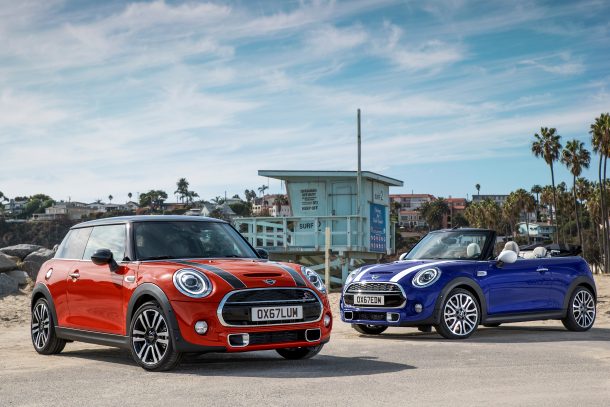Don't Thank Cars for Mini's Sales Gain

In fact, you can’t thank any of Mini’s vehicles for the brand’s 3.9 percent year-to-date U.S. sales gain, as that figures comes with an asterisk.
Mini’s compact Countryman crossover gets glowing praise in Mini USA’s May sales report, and well it should. The crossover, enlarged for the 2017 model year, pulled in 1,691 sales last month. That’s slightly more than 40 percent of Mini’s total volume in the United States. The model’s sales rose more than 29 percent, year over year, but its year-to-date increase (a whopping 61.9 percent) hides an inconvenient truth. A little math reveals a troubling trend that places the brand’s future in question.
This in’t an unfamiliar place for Mini.
When the second-generation Countryman burst on the scene, sales tanked in the changeover period, with only 188 units sold in February 2017. That skews this year’s year-to-date figures in an upward direction, though there’s no denying 2018’s Countryman sales — so far, anyway — are healthier than in years past. March was the first month since 2015 where Countryman sales topped 2,000 units.
Still, U.S. buyers will have to fall harder in love with the model for sales to reach that of the 2012-2014 period, where consumers took home more than 20,000 Countrymans a year. Last year’s sales totalled 14,863 units.
Making up the rest of the brand’s volume is the Cooper line, consisting of two-and four-door Hardtop models, the lengthened Clubman, and a convertible. Sales of the brand’s car models sank 8 percent, year over year, in May. Over the first five months of 2018, the quartet of Coopers saw a volume loss of 34.6 percent. You’d have to go back 14 months to find a month with a year-over-year sales gain.
Basically, all of the increases Mini can claim on a YoY or YTD basis are thanks to the Countryman. Without that February 2017 dip, the brand would show itself to be on the decline. Last year, Mini sales in the U.S. were off the brand’s 2014 high water mark by 29.2 percent.
Where does the brand go from here? With no new brand-diluting crossovers on the way, the only new product on the horizon is an all-electric model scheduled to go on sale next year, which can hardly be expected to make up for lost Cooper sales. Besides that, the only changes coming to the lineup is a nearly imperceptible refresh for the 2019 Cooper and Clubman.
[Image: Mini]

More by Steph Willems
Latest Car Reviews
Read moreLatest Product Reviews
Read moreRecent Comments
- GregLocock Car companies can only really sell cars that people who are new car buyers will pay a profitable price for. As it turns out fewer and fewer new car buyers want sedans. Large sedans can be nice to drive, certainly, but the number of new car buyers (the only ones that matter in this discussion) are prepared to sacrifice steering and handling for more obvious things like passenger and cargo space, or even some attempt at off roading. We know US new car buyers don't really care about handling because they fell for FWD in large cars.
- Slavuta Why is everybody sweating? Like sedans? - go buy one. Better - 2. Let CRV/RAV rust on the dealer lot. I have 3 sedans on the driveway. My neighbor - 2. Neighbors on each of our other side - 8 SUVs.
- Theflyersfan With sedans, especially, I wonder how many of those sales are to rental fleets. With the exception of the Civic and Accord, there are still rows of sedans mixed in with the RAV4s at every airport rental lot. I doubt the breakdown in sales is publicly published, so who knows... GM isn't out of the sedan business - Cadillac exists and I can't believe I'm typing this but they are actually decent - and I think they are making a huge mistake, especially if there's an extended oil price hike (cough...Iran...cough) and people want smaller and hybrids. But if one is only tied to the quarterly shareholder reports and not trends and the big picture, bad decisions like this get made.
- Wjtinfwb Not proud of what Stellantis is rolling out?
- Wjtinfwb Absolutely. But not incredibly high-tech, AWD, mega performance sedans with amazing styling and outrageous price tags. GM needs a new Impala and LeSabre. 6 passenger, comfortable, conservative, dead nuts reliable and inexpensive enough for a family guy making 70k a year or less to be able to afford. Ford should bring back the Fusion, modernized, maybe a bit bigger and give us that Hybrid option again. An updated Taurus, harkening back to the Gen 1 and updated version that easily hold 6, offer a huge trunk, elevated handling and ride and modest power that offers great fuel economy. Like the GM have a version that a working mom can afford. The last decade car makers have focused on building cars that American's want, but eliminated what they need. When a Ford Escape of Chevy Blazer can be optioned up to 50k, you've lost the plot.


































Comments
Join the conversation
The Mini thing has run its course. The car buying public has many options, most with better reliability and value. I understand that BMW marketers wanted a brand to offer lower cost small cars to buyers, but by choosing to call it "Mini" they put themselves in a fairly small box...while the market is seeking larger boxes.
No matter what what MINI marketers claim, MINI does not sell a hardtop in either 2 or 4 doors. The definition is really simple: a hardtop has no B pillar. If it still has a pillar when all the windows are down rather than an unbroken opening, unencumbered by a door frame, it's not a hardtop. Please don't give the ad guys credibility by falling for their incorrect mischaracterization of these two body styles.